13 December 2022 to 4 January 2023
Anchorages: None
Marinas: San Sebastian Marina, La Gomera, Canary Islands & Jolly Harbour Marina, Antigua, Caribbean
After spending 22 nights at sea, a warm welcome to a bright and shiny Antigua. But admittedly, this has been the most challenging time spent at sea. We have never been this afraid for our lives (though Sander said it was only the 26th that scared him), and I have never felt so helpless. But let’s start in the beginning when things were peachy.
We will not have to deal with anything other than the weather and our floating home for the next couple of weeks. No distractions, no conveniences other than what we have provisioned for. We are now a tiny blip inching across the vast Atlantic ocean toward the Caribbean. 2700 nautical miles, let’s do it.
Day 1 13/12
We set off at 9:19 with bilges, fridge, and freezer filled to the brim. We have stocked up on as many vegetables, fruit, meat, dairy, and starch as possible. Along with this, tons of instant noodles and long-life bread. Not to mention the amount of candy that would shame Charlie and his Chocolate factory. The wind is in our favour, and we sail from the get-go, with our Hydrovane, Rob, keeping us on course.
We leave a day after the Talisker Atlantic Rowing Challenge participants. This is an annual rowing race with teams ranging between one to five rowers. We are keen to track the progress of the rowing teams Salty, which has Mike Hatch (the manager of Brighton Marina) and three other Premier Marina Managers. Then there is Woobie, a group of American veterans rowing to support veterans and their charity USVETROW.org. And UK-flagged Eppy, with four brothers (two sets of twins). We met their proud parents and grandmother a few nights before while watching the Netherlands vs. Argentina football match (well done, Argentina). We promised to catch up again when the boys arrived in English Harbour Antigua after rowing the 3000 nautical miles across the Atlantic.
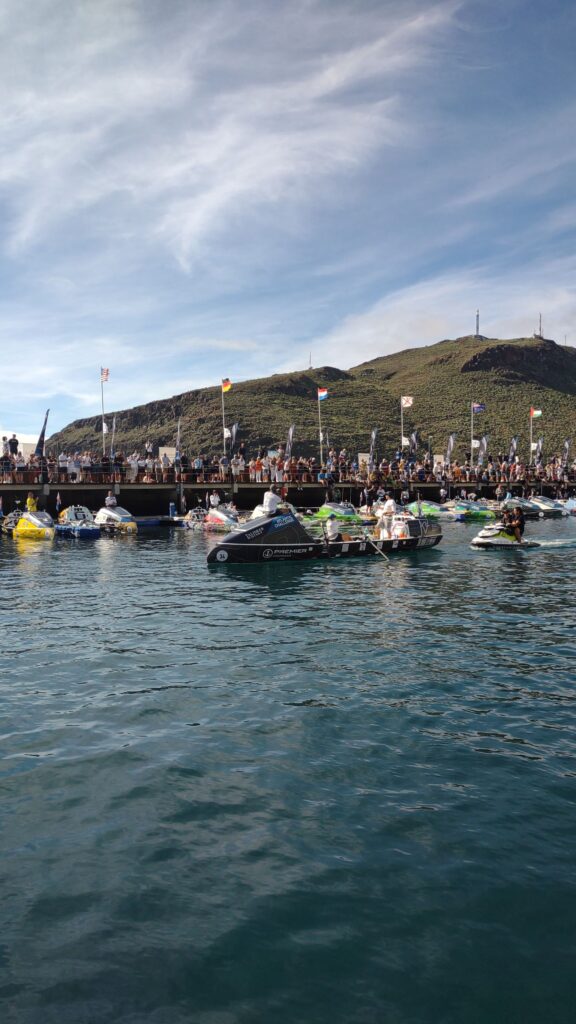
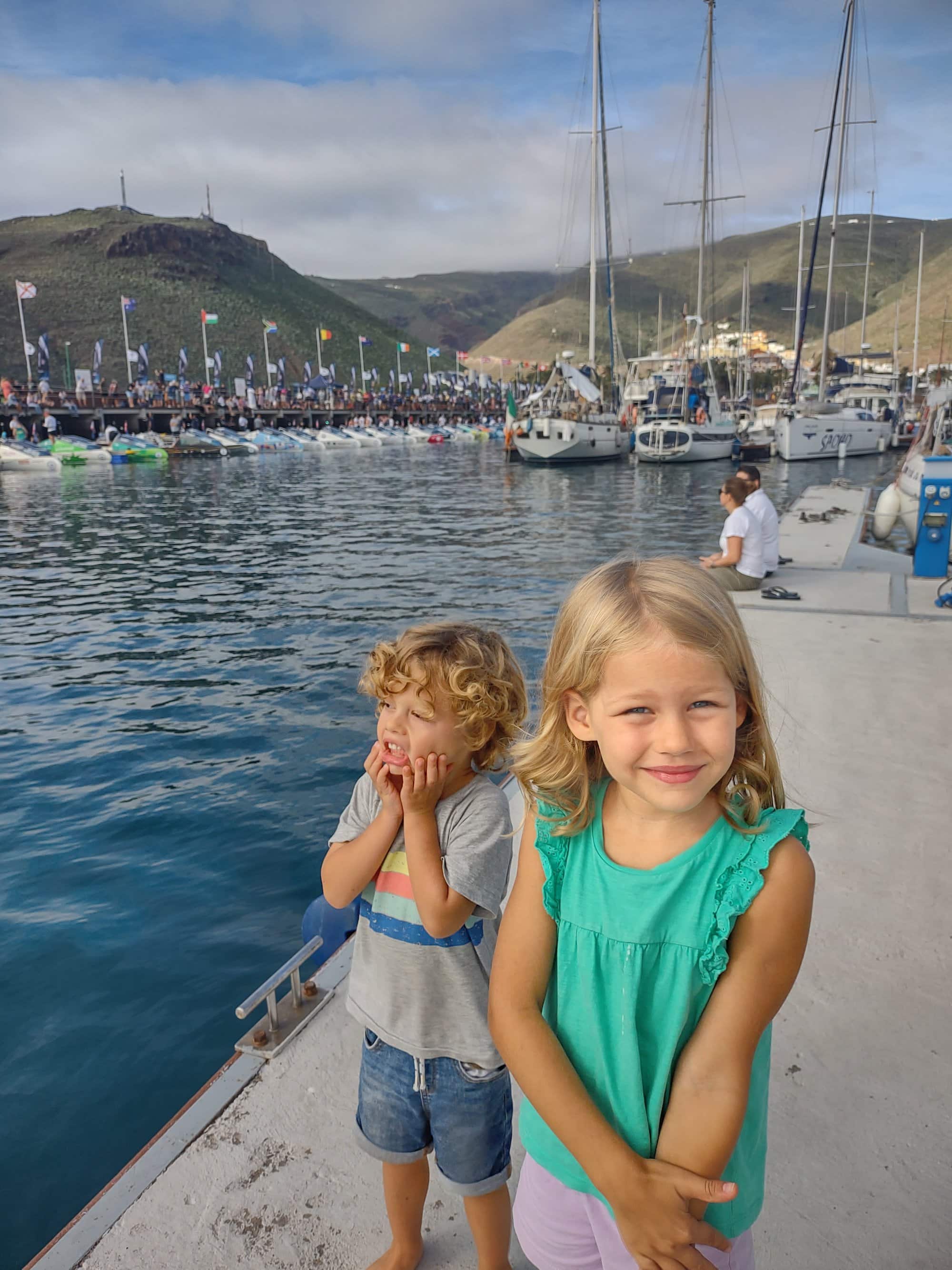
Life is peaceful, and we are energised knowing we have finally reached this point of our sailing adventure. Crossing the Atlantic seemed so big just a while back, and here we are, family, cat, and house, departing the safety of land to explore the unknown. We are crossing using only our Single SideBand Radio (SSB). With the SSB, we can download weather files and send approximately 4 MB emails simultaneously. We are capped at the number of minutes used over a week before it resets again. Remember, we are on a budget and found this a cheaper solution in the long run (this decision will be questioned along the way).
We pass a couple of the rowers and are in awe of how such tiny little vessels can cross this vast amount of water. Lunch is fish and chips, and our dinner is instant noodles with some tomato and spring onion (using our fresh produce sparingly). 14 hours in, and we still see land. During the day, we could see four of the seven islands of the Canaries, but soon this will be replaced with watery horizons. The waves start to increase, and so does the wind. Time to reef and settle into the next couple weeks of life on the water.

Day 2 14/12
During our daily inspection of the boat (it is essential to check for wear and chafe as there is no chandlery to visit to fix what is broken), we notice the mast is moving back and forth in an unnatural way. We had our rigging (the stainless steel cables keeping the mast upright) checked and set in Falmouth before crossing the Bay of Biscay, so we should be sorted, but clearly, something is amiss. We read that when you have your rigging set for an ocean crossing, the Rigger needs to set the rig for an ocean crossing and not coastal racing (which some riggers tend to do). We had a coastal racer check ours.
We fire up the SSB to email and notify our contacts about the rigging, but she is not connecting to any land-based towers. We are too far out to use the VHF, and now we need a way to inform our land based contacts, should we need help. We have an EPIRB that will send out our position to emergency services at the push of a button…but we are not in a life-threatening situation. Time to take a step back and re-evaluate. Our options now are tracking back to the Canaries (day and a half sailing) or heading for Cape Verde (seven to eight days sailing). Neither option appeals to us, and we opt to fix things ourselves.
Sander hops onto the sugar scoop (harness and life vest on) and gives the two back-stays (stainless steel cables attached to the mast and the stern of the boat) a complete turn. We go back to the mast to inspect, and now the swaying is even worse. So Sander gives it another half-turn back. We move to the inner stay at the bow and realise the rigger skipped this one. The stay is slack and we give it a few turns. There, it’s done, and our mast is looking happier again. But in the meantime, the sea motion has brought on Sander’s first bout of seasickness…ever. Throughout our nine months of sailing, the kids and I have been seasick, and Sander, the watchful captain, has done without an issue. Now, he is a combination of white and green, and his eyes mirror his feelings.

We have some dolphins swim around us during the day, and by night, the sky is a blanket of stars, and we spot some of the rowers on AIS and their navigation lights appearing and disappearing in the waves. We change our fishing set-up to a hand line towing an orange squid 150 meters behind us (thank you, Marc, for the tip). We are averaging 5.5 knots in 12-18 knots of wind. And by dawn, the wind is on our stern, and we are ready to set up the boat for downwind sailing. We pole our head sail to starboard and have our main sail out on the port side. We are now a proper goose-winged sailboat and should be able to keep this set-up to the Caribbean.
Day 3 15/12
Another ocean crossing conundrum is storing trash. A fellow sailor’s tip was to cut up as much of the garbage and fit it into any empty bottles or cans (thank you, Christina). We used to put our rubbish in the dinghy, but this is a three-week passage, and the dinghy is tied and closed up. The next best spot is in the anchor locker. We spend most of the afternoon cutting garbage and cleaning the boat (there is a tremendous amount of salt and hair on the boat). We keep heading South to avoid a strong swell coming in from the North. Susie Jane is stable, and we continue with the mundane daily tasks, washing dishes, laundry by hand, and many, many Lego challenges. And finally, we set up the Christmas décor and discussed how many celebrations we would have during our three weeks of sailing (crossing 1000nm, crossing 2000nm, Christmas, New Year, one week done, two weeks…you get the picture). Little do we know that we would not be able to celebrate any of these events the way we had imagined.
The wind is relatively stable with the occasional gust, but the waves are not. Susie Jane is moved from left to right, and the thought of us moving this way for the duration of the crossing is unbearable. This is different from how we had imagined our passage across the Atlantic. We thought the most prominent issue would be not having wind, but now we read that lately, the swell has made many sailors regret crossing in December, and all our ocean crossing ‘to-do’ lists fly out the hatch.

Day 4 16/12
This morning a happy lone dolphin entertains us with his gravity-defying jumps. And after many failed attempts, the SSB connects, and we let our contacts know all is well and download the following weather forecast for the upcoming four days. The winds are unstable today due to a depression further North, and the smacking of the sails drives us insane. But we can only think back to when we crossed to the Canaries and had no wind for days. At least now we are moving. We have been told that the best time to fish is dawn and dusk. Lines out, and we have a bite. The fish is large and glistening in the waves, but after a couple minutes, he comes off, and we put away the knife and rubbing alcohol.
We have been pondering the most ethical way of killing our catch and decided that dousing it with alcohol through its gills would be the fairest sailors send-off. Let’s see what happens tomorrow.
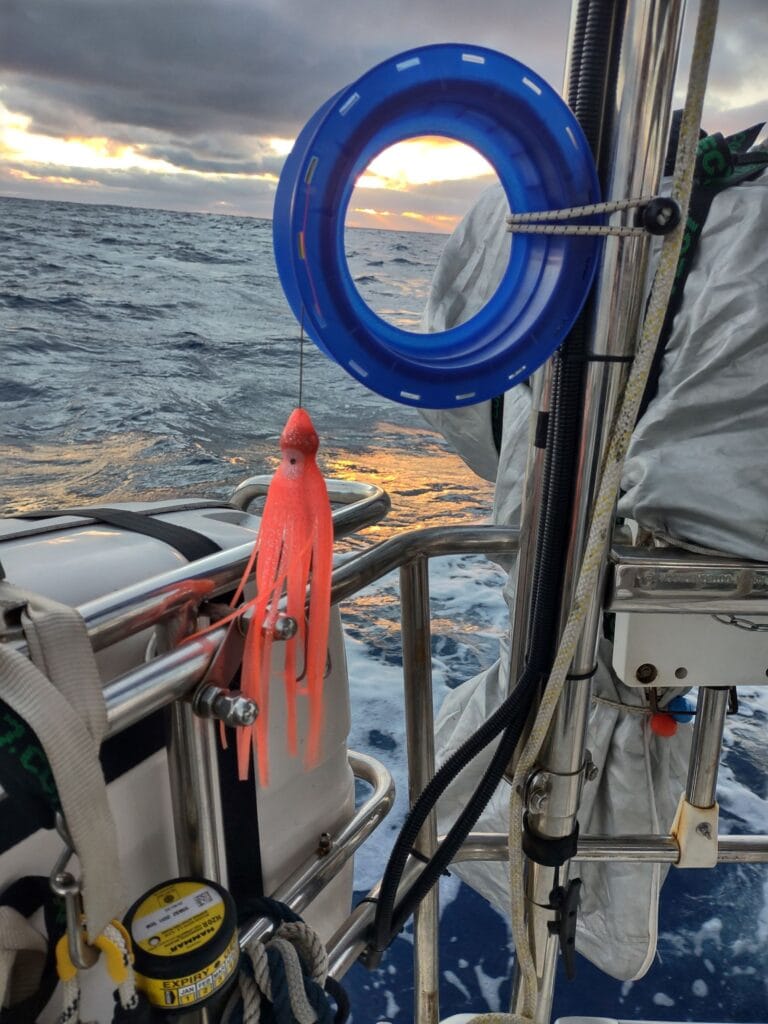
Day 5 17/12
We’ve noticed that our Hydrovane does not keep the course and steers in an extensive S line. It tracks the wind, then a wave pushes us a tad, and the Hydrovane does not correct fast enough, leaving us winding about the ocean. With this movement, we lose the wind in the sails every couple of minutes, and the waves start to bob us about. We have a B&G autopilot, but it is an energy guzzler in the larger swell, and when we use it, we need to run the engine for at least two hours at night to make up for the power decline. We have 340 litres of diesel on board and would like to keep as much available in an emergency. So we stick to the Hydrovane and play about with the settings.
The kid’s activity this morning is clay and activity books. We have noticed an improvement in Ava’s maths since switching to a free curriculum-based education system called EasyPeasy. It’s free, and the curricula are for ages pre-school all the way to year 12. But due to the roll of the waves, the kids do not do well with screen activities, and we stick to simple creative and hands-on activities.
We have both the hand-held fishing line and the fishing rod out. Now we mean business. We have something on the rod, so I start pulling in the handrail to avoid tangling lines. There is tension, but we put it down to tangled lines. There it is, a beautiful Mahi-mahi. It is a parade of green, grey, and yellow. We pour the rubbing alcohol down his gills, and his eye colour changes from dark brown to emerald green, then a turquoise blue, and finally black. We both feel uncomfortable with having taken something so beautiful from the ocean.
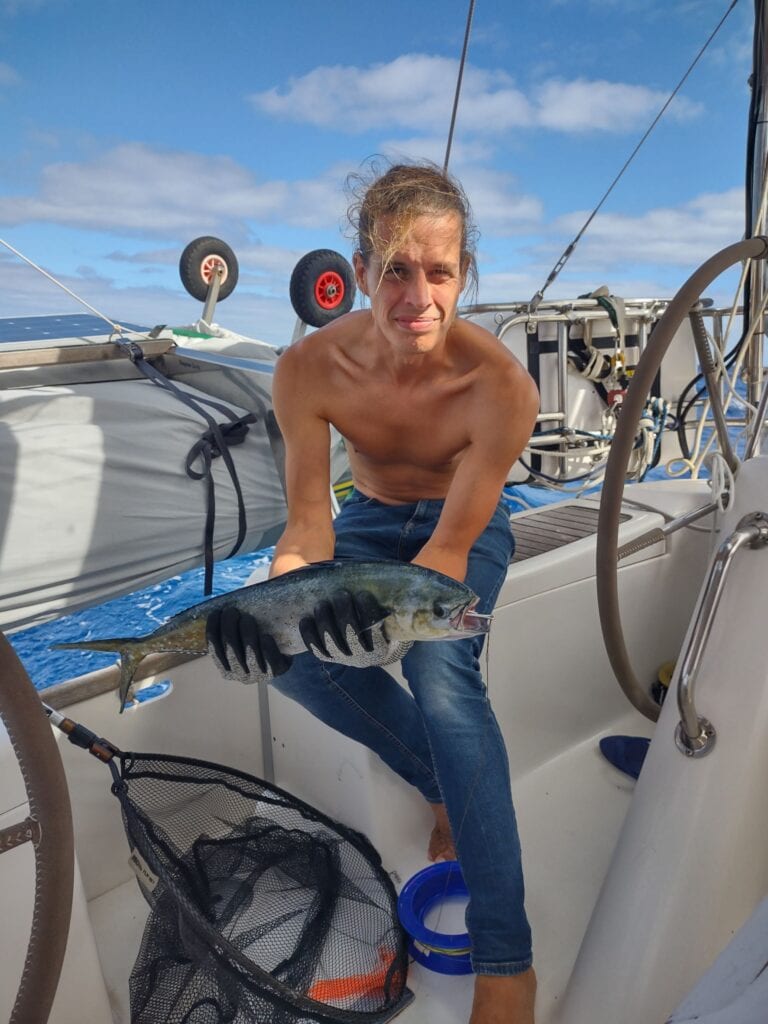
For the next couple of hours, we pole out about 3 times and then fight the waves and wind. There is a weather front coming in with some big waves, and we continue South to avoid the grunt of it. By 01:00 things have settled a little, and Susie Jane is back to a balanced boat with the wind and waves pushing us on.

Day 6 18/12
During our morning checks, we uncovered many wears and breakage on the boat. The ocean is unforgiving, and the amount of salt that collects and starts the rusting process on deck is beyond belief. We are back to having a banging boat and a cross swell. The waves are building, and we change our course to ensure we have the push of the waves on our stern. We have a couple more pole-out and furling-in moments.
Lunch is Mahi-mahi with fried rice, and it tastes incredible.

The only boat we have seen is a fishing boat on AIS. And we have spotted a couple of buoys floating about…hopefully we do not have another fishing-net incident, as we did crossing to the Canary Islands. Today, both Sander and I are in a better mood, which is down to us getting used to the roll of the boat and the daily routine. We joke about the many bumps on our bodies and Sander’s new copper sun streaks. We now have both our poles set. One on starboard and one on the port. This would be more efficient when the wind should turn. We have also become faster at setting the pole and reefing in without turning Susie Jane into the wind. We feel like the power team we had imagined we would be back in Brighton.
During our watches, the person who is off would sleep in the cockpit. We are used to this and have not dared to leave the other alone. Early this morning, there was a distinct rattle on the boat…I could smell the source but not locate him. And then, finally, a flying fish landed by Sander’s toes as he was sleeping. Wedged between Sander and polyester, he had almost no chance…but we found him, and he can be on his merry way. Flying fish stink…worse than cheap fish-flavoured cat food.
Night watches are fun, but there are nights when not even the glow of the bioluminescence, reading, or gaming can keep you awake. You literally stare into the distance and start dreaming with your eyes open. You suddenly jerk yourself back to reality and watch your partner enjoy a peaceful slumber. My solution, leg-lifts, push-ups, anything that keeps you moving in the confines of the cockpit.
In addition to working out to keep yourself awake, there is the trusty old coffee solution. We were recommended to purchase some Yeti flasks, which are a wonder. They keep our coffee piping hot for at least 4 hours. And when you have cold water in them, they stay icy. Granted, they are expensive, but they are one of those products you only buy once, rather than the ton of useless flasks we have on board already. We treat ourselves to a French-press coffee once a day, and I swear, it tastes like a high-end hotel coffee in London out here.
Day 7 19/12
Another Mahi-mahi on the handrail with the orange squid. This one is larger than the previous one, and we have another show of eye colour and regret taking something so beautiful from the ocean. The waves and swell are gigantic, coming in from three directions, with the strongest to our stern. According to the Jimmy Cornell’s World Cruising Routes, we should officially be in the trade winds now. We have about 16 knots of wind to our stern, pole-out to starboard, and main sail to port travelling at 5.8-6 knots. Green curry Mahi-mahi for lunch.
We have an astronomical amount of spotted dolphins swimming around us. There are hundreds, and they are everywhere, as far as the eye can see. Some jump, and others surf the enormous waves.
The wind is building, and these waves are not subsiding. We plan to tack from the starboard pole to the port pole, but this does not go to plan, and the sheet gets stuck. The sheer force of the wind on the line is scary, and we can understand how people lose limbs and fingers in the process. Luckily we come off with a few scrapes. The kids enjoy their daily exercises, and Nova becomes more daring when outside. She enjoys watching the waves crash against the hull and, at times, looks like she is about to jump in and inspect.
Sander and I have changed our course to stay closer to the 20-degree line. The wind (speed and direction was not forecasted) and the swell builds so much that I wonder what would wait for us on the other side of the weather file we still need to download. Should we reef and decrease the sail area, or is this just a little gust? We go with our gut feeling and reef our main and head sail all the way… a good change as we still make between 5-6 knots of speed.
The sea changes at a tremendous speed during my night-watch, and I am rattled. What gets my stomach in a twist is feeling the boat move from side to side and not being able to see what the waves are doing. What I can make out in the darkness are waves towering above our dinghy and white crests rolling towards us (we have left the dinghy inflated and securely tied on the davits should the need arise for us to jump ship). The intervals are unforgiving, and there is another every 5 seconds. Sander is sleeping (he has not been sleeping much and needs some rest). The kids are in bed, and Nova is in cat heaven on the couch. My family is resting and relaxed, but something is brewing.
Friends of ours have recently crossed and said it was mostly uneventful. They were even able to swim in the Atlantic…what is happening here? We have just under 2000 nautical miles to go. And if the conditions stay this way, we will be proper wrecks. I can only make notes and play maths games to distract myself. Exercising is a thing of the past. A push-up or sit-up in these waves requires more balance than I have in me. It is the first time I understand why people sell their boats after crossing an ocean. Would we feel the same, or as it has been put before, sailors have sailor’s amnesia, and this scary evening will soon be forgotten.
We have been struggling to connect our SSB to either Trinidad or Belgium stations and have no way of knowing what the weather is doing or will be for the upcoming days. And just like that, it all subsides, and things go back to normal. By 4:20, the moon appears with an orange sliver of light. We change our watch times to 4 hours on and 4 hours off to get some well-deserved sleep; we are both suffering the consequences of too little sleep.
Day 8 20/12
We celebrate one week at sea with some chocolate from our advent calendars. This way, we keep track of the number of days at sea. It is strange how fast you forget which day it is or even how many nights have passed. The swell was meant to subside, but no such luck. It’s the sort of swell where you can only sit, hold on and watch. We are joined by many flying fish jumping out of the way of our bow bashing into the water. We managed to get another grib file for the weather for the following three days; we will have the same swell and periods of less wind. Hopefully, it is manageable.

Sander has the first shift this evening…and as I slip into slumber, I can hear Sander frantically trying to balance the boat…sleeping will have to wait. Winds peaked at 27 knots, and the waves keep rolling and twisting Susie Jane. We have the Hydrovane on and on a storm setting and lashed the helms to compensate for the weather helm. With these waves moving so fast and erratic, Susie Jane can not seem to settle. We have three instances where the head sail (fully reefed) backs as the Hydrovane can not adjust fast enough for the confused waves.
You must be wondering what the size of the waves are? By this point, we have waves ranging from 2.5 to 3 meters. The occasional rogue wave surpasses this measurement, but they come every hour or so. We decide to switch over to our autopilot and bite the fuel bullet. This works well, and the autopilot corrects fast enough to avoid the sails backing. We are moving between 5.5-7.5 knots with the main and head sail fully reefed.
We watch as two bellowing waves race towards our stern quarter and splosh into the cockpit. Is it drogue time? A drogue/storm drogue is a device attached to the stern by a long line. A drogue slows your boat down in a storm, and prevents the boat from turning side-on to waves. If you are side-on to the waves you stand a great chance of being rolled over.
Our drogue was bought from a chandlery and fits the size of our ship. It looks like a large cone. All we need to do is attach 150ft of mooring lines to ensure it will tail behind Susie Jane and reach a wave or two behind us. We set up our drogue. In Voyager’s Handbook and the Storm Tactics handbook, we read up on the general storm tactics employed.
We had never thought we would get caught in anything, and here we are, wondering if we would have to heave-to or deploy a drogue. With the drogue ready, we feel more prepared for the unexpected (we should have done this before). In addition, Sander fixes our GPS transponder to transmit its location via VHF DSC should we get into a hairy situation. We have swapped our t-shirts and shorts for salopettes (the equivalent of dungarees for sailors) over trousers and jumpers candy wrapped in a safety harness. And all we can do now is wait.
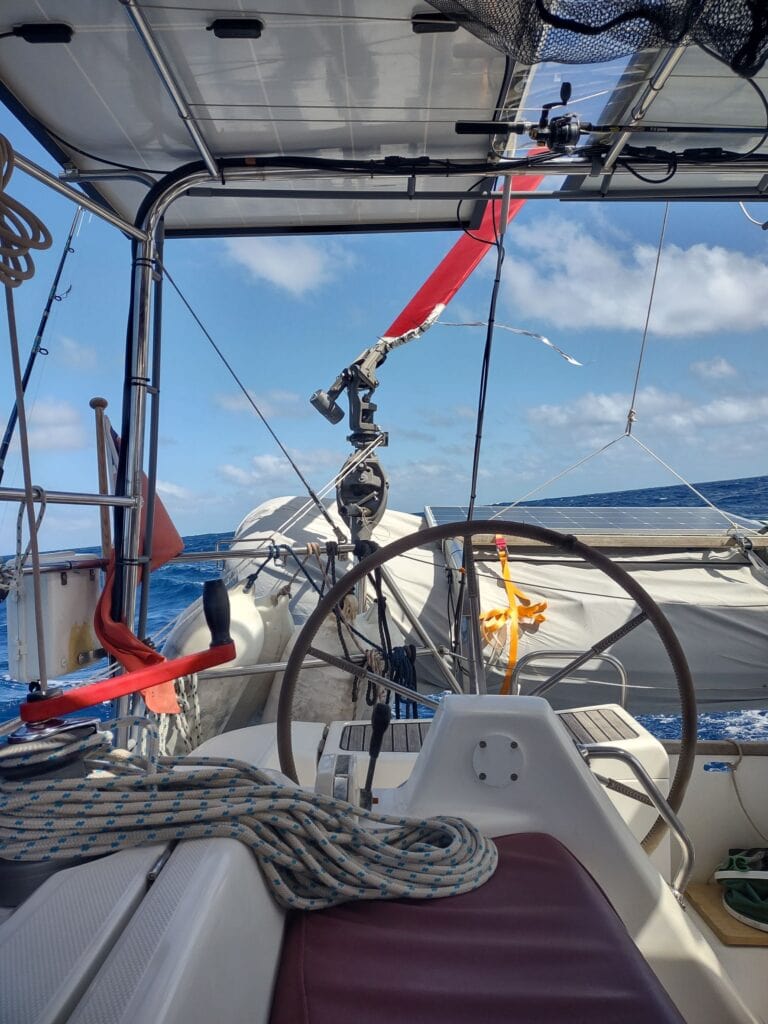
Day 9 22/12
Sander and I are now officially broken. We need to be thinking straight, and moving is becoming a chore. We need to change our four-hour watch rotation, as this is not working. We now set things up so that the person on the watch can sit inside for their watch and only do 20-minute checks upstairs. The person off will then sleep on a soft bed in the bow. The sea is a mess, and the thought of preparing a properly cooked meal or catching a fish is something left 200 nautical miles behind us. There is a depression passing over the North Atlantic, bringing an additional swell to our starboard. There is no stopping the force of either the northern or eastern swell. The sea is so cross and confused. And these are the most gigantic waves I’ve ever encountered.
We run the SSB, and after 24 minutes, we have a new grib file for the upcoming 4 days and a response from friends sailing about 150 nautical miles ahead of us. They, too, are experiencing more giant waves and more wind than predicted. The inside of Susie Jane has become just as confused as the sea. Once she is cleaned up, we make a proper meal, and Ava chooses for a poke bowl for lunch. Maybe there are better choices for food in these waves, but after 3 hours of catching and holding bowls, we enjoy a sit-down meal.

The waves carry on for the rest of the day, and we surf down two waves at 9 knots.
First time sleeping in the bow, and it is heavenly. The bedding still smells fresh, and the movement in the bow is not as bumpy as we had imagined. We have instant noodles for dinner…again (this has been our go-to meal for the last couple of days). The long-life bread we had planned to use has gone mouldy, and with the cloud cover and sail shadow over the solar panels, we are not making enough electricity to make bread. We test the water-maker, and it is sucking up loads of air. If the conditions stay this way, we cannot make water. So we start becoming more frugal with our water. We are down to a tank and a quarter (about 350 liters).
Since being able to sleep downstairs, things have calmed down for Sander and me. Out of a force of habit, I still sit most of the time watching the sea and sky. We keep a close eye on the wind and now the Barometer. We need help if the Barometer should start decreasing significantly from our current 1030 bars. Our shifts run from 8-12pm, then 12-4am, and we split the last four hours into two-hour shifts each. The wind is shifty tonight, ranging from 10-25, with the swell doing her best to rock us to the point of being unbalanced. By the way, the Kewpie Mayo for the poke bowl is off. William and I have very active stomachs. Not something to have on a watch with an over-sensitive radar that rings for every big wave.
Day 10 23/12
Spirits are a little low today. The swell persists, making for an uncomfortable ride. Susie Jane is jerked from left to right in an unharmonious way. The wind has slowed down, making it almost impossible to use the Hydrovane. With the boat rocking about on the waves, there is too much air coming into the water-intake for us to make water. The kids are happy and play Lego, Jenga, and watch some films. They have not been seasick for the last week and only complain if they have to tidy their rooms. The sea is so confused, and Sander and I joke about how simple we thought this would be. Tomorrow we will be able to download another grib file. The current one shows some stronger winds coming up. Today was also the first time all four of us had a wash; it was a two-litre per person wash, and much needed.
Up to this point, we thought the worst had passed, and we felt we had uttered our last bad word when, suddenly, we were hit with the next challenge. Our batteries have run under 12.08 volts, and the engine will not start. There is a ton of cloud cover, and the batteries are not charging. It is mid-morning, and we can not find the fault. If we can not get the engine to run, we cannot charge the batteries to run the autopilot during the evening. The SSB also needs electricity, our only means of communicating should things go belly-up.
The starter battery for the engine looks low, and we attempt a jump start from one of the house batteries. Nothing. Next, we connect the engine directly to the house batteries (this takes a while as we install a new combiner switch between the battery banks; of course a job that was on our long list). Still nothing. We check all the cables, connections, and fuses. Still, no change. Sander and I take a breather on deck and realise how ultimately (bad word) we are. Cape Verde is 600 nautical miles behind us and into the beating waves. The Caribbean is over 1400 nautical miles away, and a salvage would take days. Why did we do this? Why did we bring our children into this mess? Is this the end of our big dream?
The boat is a mess, and all the kids want is the film day promised the day before. We explain how there might not be any films or tablet games or even lights. If we can get the engine to start, we will head for Antigua; else, we will turn back to Cape Verde and have what ever the fault is, fixed.
And then, finally, by sheer chance, Sander finds the culprit. The cable running to the starter solenoid has rusted through. A quick repair and she starts up, and the clouds dissipate by the magic of these waters.
The boat is back to being in good spirits. With the children watching some films, Sander and I can appreciate how desperate our situation was, and finally draw a fresh breath of optimism in.
The engine starting has taken most of the day, and now it is time to focus on the other maintenance worries. Our Hydrovane has been making a ticking sound, and we cannot pinpoint the location or fault. We wash her down (sparingly) with fresh water and WD40, after which Sander tightens all the bolts. There is a couple minutes of silence and then, the tick emerges from its unholy hiding spot.
There is a lot of salt on the boat, which will corrode many of our steel fittings. Again, exceptionally sparingly, we wash the rigging and any necessary steel fittings.
Our SSB has stopped tuning, so Sander installs the backup tuner (we have learned that you need spares for almost everything). We can transmit and receive again!!! We have a new grib file for the weather until the 28th of December. It is not looking good. The 26th is forecasted to have waves reaching 3.5 meters and the wind at 26 knots. In the past we have appreciated that weather forecasts are exactly that…a prediction and not definite. When we read forecasted numbers now, we add another third of the wave height to the average and about 5 knots to the wind.

We have a friend check the weather for us on land, and he confirms that it will be bumpy, but manageable with our Hydrovane. Nothing much we can do as the high swell and wind reaches across most of the mid-Atlantic. We need to pull up our big girl salopettes and deal with it as it comes.
We have our first squall. It’s a tenacious little cloud build-up that sneaks up on you and then tries its best to blow your boat over. It is to the point where you will be sailing with a wind speed of about 15 knots, and then, within a minute, it’s blowing 35 knots. It passes after a couple of minutes, and then you have rain. The Radar picks up on them but gobbles power. In addition to the squall watching, we keep an eye out for any ships without their AIS on. Friends who crossed with the ARC recently had a run-in with a Russian cargo ship without its AIS and barely any VHF communication.
Our Barometer maintains 1030, and we are now surrounded by a blanket of twinkling stars and shiny bioluminescence. The air is much warmer, and the water temperature is up to 27.5 degrees.
We wonder how the rowers are and can appreciate the distance they need to cover at an average speed of 2-3 knots and hour. When we set off, I imagined a row across the Atlantic doable; now, it is super-human.
Day 11 24/12
We are both so tired. Tired of the roll, tired of being at sea, tired of instant noodles and soggy pants. Tired of sail changes and coiling lines. Just tired. It’s reflected in the amount of movement that happens. After lunch, we continue a time-old tradition from my German grandparents. We start to celebrate Christmas a day early. We usually open our gifts in the evening, but on this occasion, the afternoon will do, so we have time to focus on sailing and watches during the evening. The gifts this year consist of Lego and monopoly. The afternoon is spent building Minecraft and Starwars Lego scenes and enjoying a glass or two of Bowle (a German drink we enjoy during the festive period). This is one of the few times we relax and connect as a family. We are energised and excited to be heading to the Caribbean. It feels like Christmas and we wonder how you all are and what you are up to?

The swell has become progressively more intense with building waves. Neither of us feel good about it, and by 22:00, things kick off. We have three waves that are so big we both rush for the drogue. Now we are both on edge. The waves come in succession of three towering waves every seven seconds. We both need to sleep, so Sander heads down. And just like that, I see an enormous wave that has swallowed its predecessors and successors. It lifts Susie Jane and flays her from left to right as we surf at 11 knots. Susie Jane and the autopilot are barely in control. The water rushes through the freeboard and into the cockpit. This adventure has just become real.
After experiencing the surf of that wave, Sander and I spend our watches back together in the cockpit. We take hourly naps when we can, and fill ourselves with tons of coffee to stay awake. These waves were not forecasted for today, and we can only imagine what is coming for us on Boxing day. (BIG BAD WORDS)!!!
We both wait for the sun to appear as if, by some wonder, this will fix everything. We head inside the boat, and Sander goes for a well-deserved nap. In the meantime, I try to keep the kids blissfully unaware of our stress and suggest a game and film day (again).
Day 12 25/12
Merry Christmas!!!
The waves continue to pound at us, and the wind remains the same. Sander and I are on full alert and highly exhausted to the point where moving a line is a task on its own. Fatigue is a horror.
We try to maintain the Christmas spirit and remind the children that Santa has come to visit the boat during the early morning hours and filled their Christmas stockings. They are exceptionally excited and try to figure out the logistics of Santa and his reindeer on a bobbing Susie Jane. We aim to have a special Christmas meal, but all of this will have to wait until we reach land.
By now, Sander and I keep a vigilant watch for the big waves and wind to start. The night is filled with squall after squall, and there is little sleep. By now, my anxiety is all over the place, and I cannot touch even the autopilot for fear it will stop working and we would be tumbled into the water. And poor Sander, who is not allowed to leave my side.
A friend gave me some left-over medical uppers to try (no harm in trying new things on a rainy day). That will be today. A couple minutes later, I’m back in control of my emotions and body. But this is an upper, so there is no chance of sleeping. Squalls keep passing over with more wind and rain. We notice that our main sail top batten (the rod that gives the sail some shape stuck in horizontally) gets stuck on the spreaders (they look like arms on the mast and channel the rigging to their individual holding points). We need to correct this and try a couple of techniques that do not require us to turn Susie Jane into the wind, as the waves are sure to push us over.
There is a saying, ‘Red sky at night, Shepard’s delight. Red sky in the morning, Shepard’s warning’. We have the reddest sky I have ever witnessed, and I hope the rhyme is only a rhyme. By 8 am, things started kicking off and sitting here in the safety of the future, I feel like grabbing another upper. But here goes…
I go downstairs to wake Sander for his watch. The wind is blowing between 20 – 24 knots, but as we come upstairs, the sea has changed, and we are now in huge waves creating hollows and hills. The wind quickly increases to between 28 – 38 knots. The batten keeps getting stuck in the spreader, and we cannot change this in these conditions. We get the first couple of huge waves and anxiously watch the autopilot turn the boat stern-to to the oncoming waves. The wave picks us up, and then a couple of its friends fling us about on the crest before the swell spews us downhill again. With the current wave height of approximately 4.5 – 5 meters, we need keep Susie Jane’s stern in the waves to avoid waves beam-on.
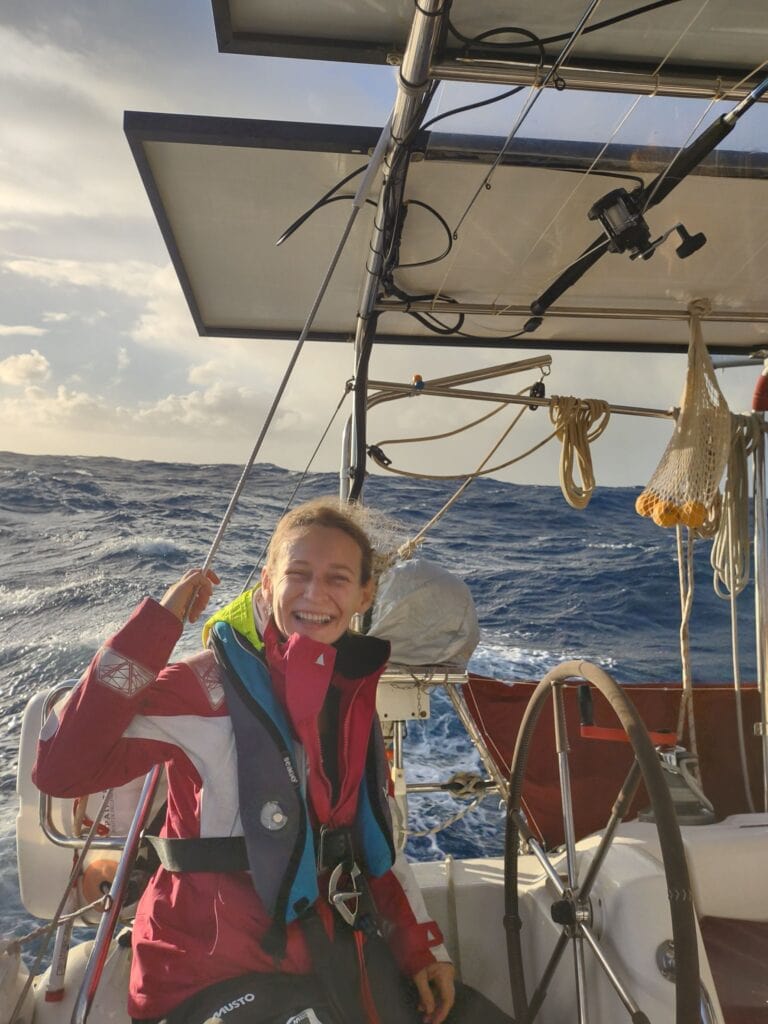
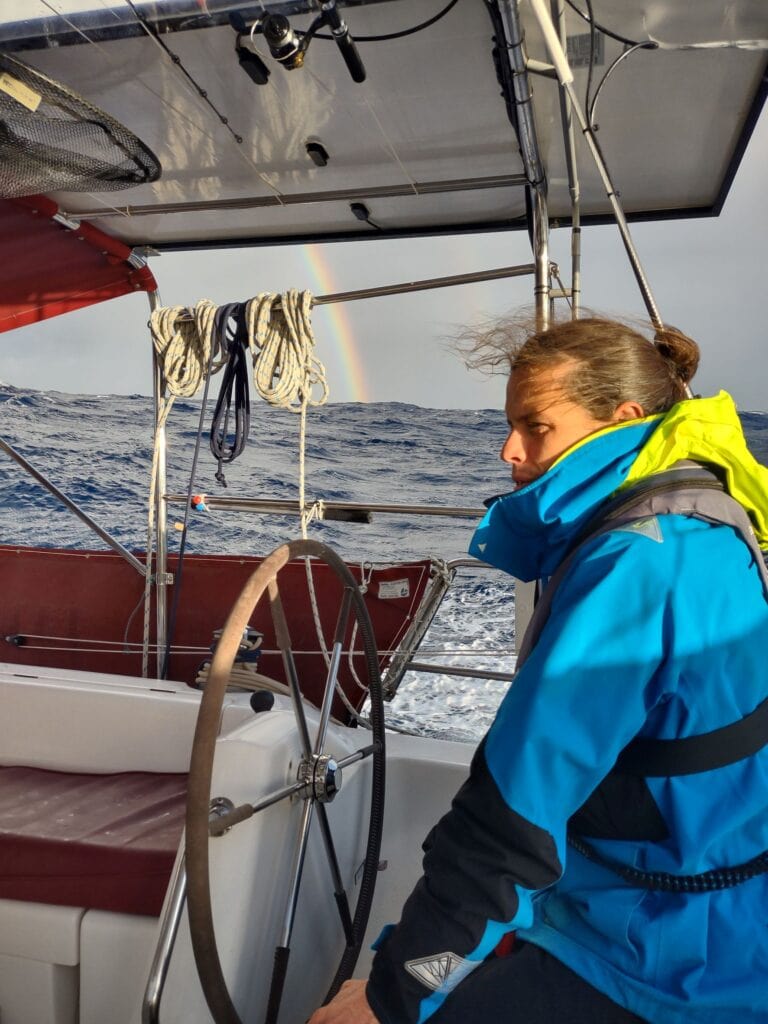
Day 13 26/12
By 10 am, we are convinced that ocean crossings are a thing of our past (we document our fear for when sailors amnesia sets in once on land). This is really hard and scary. No sailor can prepare you for an unforgiving sea. We start to wonder if the said depression coming our way has already arrived. The waves are 4-5 meters and come in a succession of 3 every 4-5 seconds. Has the peak of the storm just passed? But we are wrong, and this was only the start of it all.
The waves start to build higher and higher around us. How can the sea become more fierce? We now have mountains of water rolling behind us (its starting to look like parts of the film – A Perfect Storm). The crests are building and we can only hope that they do not start breaking on top of us. The wind picks up to high 30s and mid 40s.
The Autopilot is unable to keep our stern in the waves due to the force and speed of the waves. Sander is now on helming duty. I attempt to maintain the boats heading and correcting for the waves, but, the force is too much for my arms. As Sander fights the strength of the waves outside, I settle the children downstairs. We do not want them to see what the ocean looks like, nor how afraid we are. The solution, a free day downstairs. Eat as much candy and play as many tablet games as you like. I mean, in all honestly, if this is our last day, I want them to be blissfully unaware.
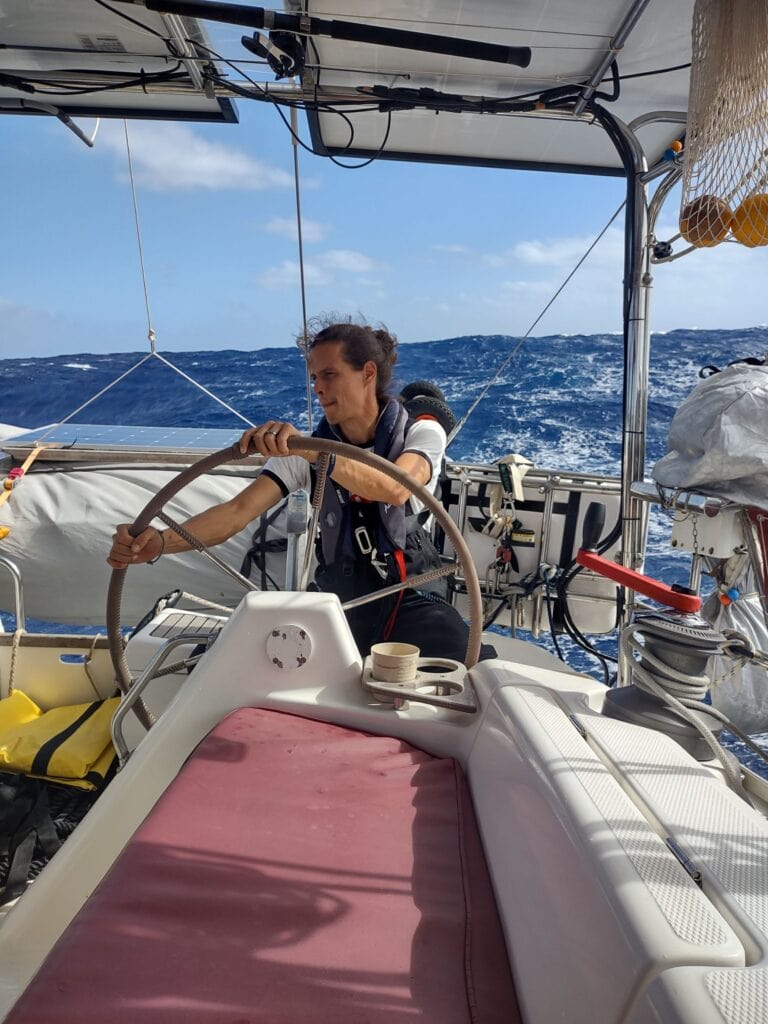
Then back outside. Every other wave is building to be stronger and taller than its predecessor. These mountains continue for as far as I can see, and there are no hopeful words to give Sander for what is coming our way. We are petrified now and struggle to maintain light conversations.
Sander has been helming for 4 hours now, and the strain on his body and mind starts to show. I don’t know how much more of this he can take. I can feed him candy, coffee, and water through a straw. If he loses focus for a second, we start rolling down the wave at an undesirable angle. At specific points, it feels like the waves are taller than our mast, 16 meters up (don’t worry, this is not the case). But they are more like 6 to 7 meters high and keep rolling in as far as we can see. As the waves roll, the strong winds lift water and blow them like avalanches heading down a ski slope. When you look towards the bow, you’ll see the bow dipping down into the water while the stern is shoved forward. I watch a couple of waves that have just passed under us break. This is not looking good for us.
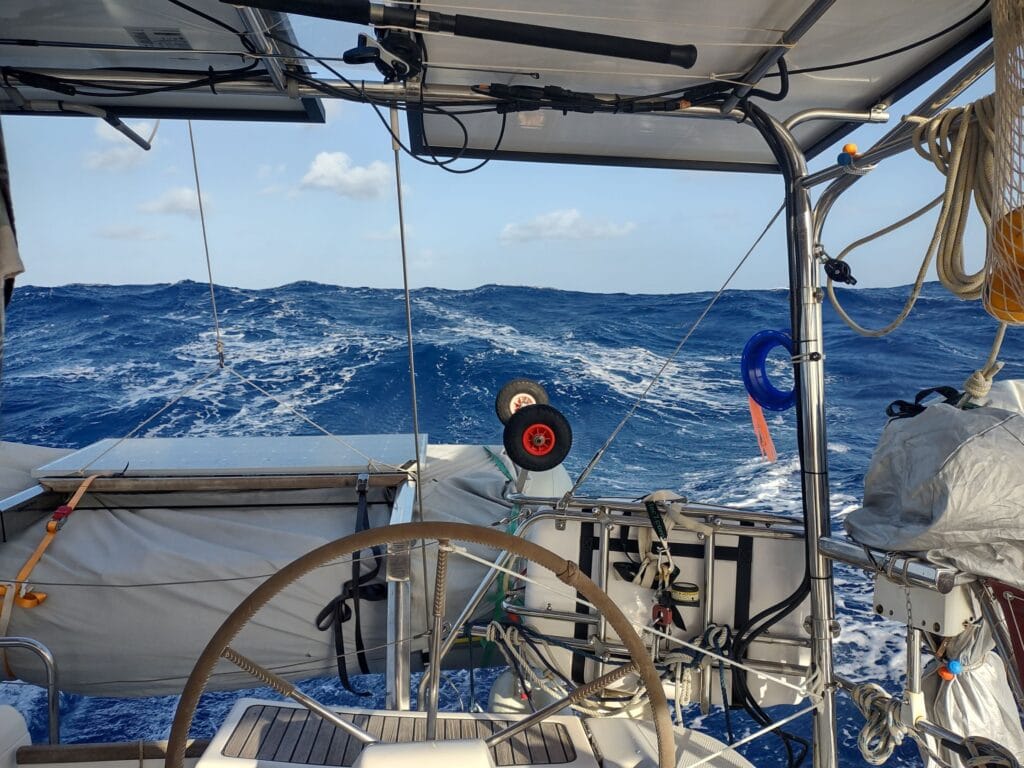
We are just under 1000 miles off Antigua, and no one will be able to save us should we lose control. The weather and waves were meant to calm down by 18:00, but this is far from the truth. The waves from 19:00 are violent and significant and thrush us from side to side. We had a wave break into the cockpit and spilled into the boat wetting the kids and filling some bilges. Secure all hatches now! The force of the waves on the stern forces water through the sugar scoop hatch seals…please don’t let them break! The sea is just building, and there is no end in sight. And then another monster wave breaks on top of our solar array (1.94 meters above the cockpit) and washes Sander and me around the cockpit. Sander barely maintains his hold on the helm and then he is back up again fighting the ocean that is sure to take us to the bottom of the ocean.
I feel helpless and regret putting Ava, William, and Nova through all this. What were we thinking coming out here? Is this where our lives end? We are so ill-prepared…why did we not practice storm tactics? We have never done a hove-to for storms or deployed a drogue…what are we going to do to save our family and boat from these waves?
And then, we start seeing more waves breaking…(BIG BAD WORDS)!!! If the waves start breaking, we stand an even better chance of being overthrown. Sander and I have been reluctant to use the drogue as we are unsure of what will happen. In addition, we do not want to attempt a hove-to in these conditions just in case we get it wrong and get the wave beam-on. We have winds between 25 to 43 knots and a confused sea. The stupid batten is still stuck in the spreader. It has dislodged itself twice now with a rogue wave taking the wind out of the sails, but after a couple minutes, another wave puts the batten right back in its wedged position. The rogue waves pounce on us every three minutes, and the Northern and Eastern swell is becoming unpredictable. We are not safe anymore and are bound for the depths.
Is this Neptune’s payback for taking the beautiful Mahi-mahi? Is this a sign? Cause if it is…yes, I’ll stop; please make all of this stop. I want the boat to be safe, I need my family to be safe, and my children to grow old; they are too young to die now. They have not even started living. What have I done? Please stop!!!
And then, we are hit by a huge wave that flings the boat to an almost beam-on position and we surf down at 17.4 knots (our boat’s maximum speed would probably be 9 knots). We are officially (BAD WORD)!!!
That’s it, and we deploy the drogue. Due to the sheer amount of water and force the wave hit the cockpit with, the drogue line has tangled. We attempt to untangle it, but the speed at which the line is leaving the cockpit, means we might get caught in it and dragged in too. We let it run, and wait to see what will happen next.
The drogue catches, and the boat comes to a slow, balanced speed of 3 to 5 knots. The affect of the drogue ensures that our stern is constantly pulled into the waves and we can maintain control again. Why didn’t we do this sooner? The waves are still crashing around us, but now, our stern lifts up on every wave, rather than a hit or miss of waves slamming into us. We both get to breathe and can finally check what has gone amiss thus far. It is so strange watching this yellow drogue a couple waves back. The mooring lines go slack, and when you think the boat is about to be drenched, the lines go tight, and we are stern-to at the top of the wave again. We are so controlled now that the children and I have a chat about what has happened and play with the Lego. All is peachy again. And then, a cry for help from Sander in the cockpit.
Your partner or child screaming for help chills to the bone. The drogue has broken, and we are back, tumbling through the waves. The kids are ordered to their rooms and into bed. Everything is okay my beautiful children, but we need you to go to bed now.
Earlier, we had said that we are so happy that the bad weather is during the day as we can see the direction of the waves and how to counter-steer…and here we are, it’s getting darker, and we have waves coming from three directions now. (BAD WORDS). The weather model predicted less wind and waves. The sea has now become a washing machine of mountainous waves directing themselves into the cockpit. With Sander fully back on the helm, and me shouting out when I see a wave that might knock us over, we need to consider what we can use as a drogue.
We connect all the fenders (used to stop the boat from getting damaged on the pontoon when moored – like little bumpers) to a line and deploy it. Our situation is mostly the same. Next, we decide to deploy our spare head and main sail. We have recently had both serviced, and the cost for our head sail alone was £1400, but now we will need to use them to save our lives. Once deployed, we can feel the boat slowing down to a manageable speed.
I can not believe we are still here, still alive and still above the water. But then, that chilling call comes again. The head sail has snapped loose when the 12mm line we used to attach it to the boat broke in half. You feel this effect instantly as Susie Jane is racing again through these psychotic waves. We must be doomed?!
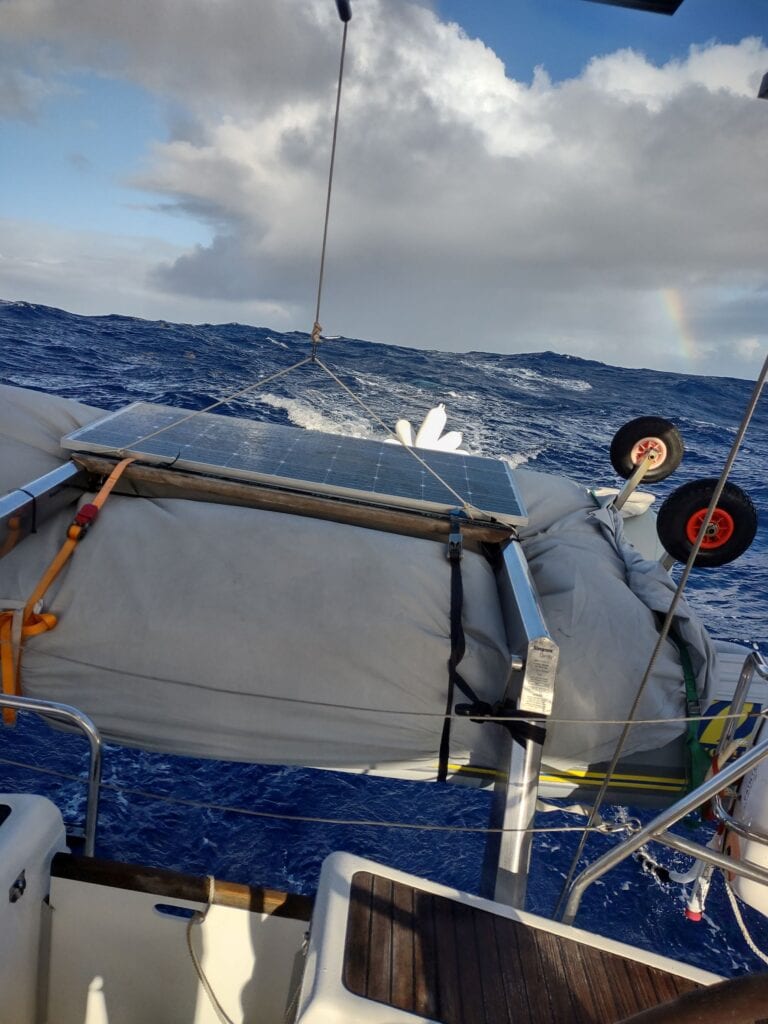
Okay, we need to rig up something else to stop up surfing unbalanced. We are starting to run out of lines to attach things to. We have used up all our mooring lines, spare sheets (lines used to control sails), and random Dyneema lines. I scramble inside the boat to find anything that will create some drag. All we have now are backpacks. We rig these up to the last long lines and hope for the best. The boat settles and we are back to a manageable pace.
We are so tired by this point that we are not thinking straight. We constantly watch for the white sail in the oncoming waves and check the lines attach to the deck cleats, hoping non of them would chafe away. By this point we know we have nothing else left to create drag, and if the main sail should break away, we are done for.
And this is when we lose all hope and start considering how we will leave this beautiful world and make it as comfortable for the kids as possible. Our children are top of mind, and I feel horrid for bringing our two beautiful children out on our ego trips. Our final decision, should the sail release, is to wake the kids, pillow up the bow, grab as much food and water and wait for the boat to roll. Should this happen, we are padded up and together as a family.
In these conditions, getting into the life raft is not an option, as we would most likely tip over even sooner. We are so scared and helpless. Our last proper meal was the night before. Our muscles are done from all the steering, pulling, bracing, and holding. We are too weak now and do not dare leave each other’s sides. We need to sleep.
And then there is hope when the autopilot manages to hold against the waves. Sander takes the first sleeping shift in the cockpit. We place the seat cushion on the cockpit floor to avoid being flung into the water. I brace myself between the seat and the cockpit table with every wave. I keep an eye on the waves coming towards us to see if I can see the white sail in the water. This has become the White Angel, and seeing her in the next towering wave brings hope and a sense of relief until you wait to see her in the next wave.
We have squalls every half hour, bringing along more rain and wind. The cockpit is drenched, and Sander is sleeping in a pool of water. By first light, I take my turn on the watery bed. It is my best hour, and I fall asleep immediately.
I wake up to my husband crying. Before the autopilot worked, Sander says he did not have any more energy to steer the boat and feared for our safety. We are both all emotions. And the ocean is not done with us yet. The waves building behind me are large again…and look all too familiar. Another upper in and I enjoy my first meal in two days in the cockpit.
A couple hours later and it is my turn…I bust out in tears. How could we be so irresponsible not to work through a storm plan? Looking at these waves, I am not sure I can continue.
I’ve now become afraid of waves crashing into the cockpit as I associate this with an uncontrollable boat and sea. And then, there is some magic in the water. A Mahi-mahi is swimming around the ship, chasing up the flying fish. He is a handsome fellow and brings along a sense of relief. The children are none the wiser of our emotional states, or the chaos happening just off Susie Jane’s safe enclosures. Outside, the sea is still wild, and we are grateful that our ‘White Angel’ is still there with us. These waves and wind should have left us long ago…what is going on?
Day 14 27/12
The day lags with our rotation of sleeping, worrying, eating, and thanking the unknown forces for keeping us alive. The sea state is not improving, and the wind is still howling at us. And then we have a break, the waves are calming, and we now have waves between 3 to 4 meters. We attempt to contact our family, but it’s too cloudy to use the SSB. We should have bought a Satellite phone…how stupid! The boat is a mess after the manic panic looking for drogue substitutes.
During my night shift, I carefully move around the cockpit, coiling up the lines and trying to create a sense of order. The sea is smashing around me, and then I hear that familiar sound of a rogue wave. It crashes into the cockpit and drenches me. Soaked to the bone, I head downstairs for another change of clothes. These waves will be the end of me.
On Sanders shift, the wind blows a little more, and the wave increase in size and frequency. Three hours later and it is kicking off again. We are faced with a vast sea and gale winds. When will this all stop? We continue our watches together in the cockpit. One sleeping on a soaked cushion while the other keeps a watch on the waves and spots the white sail in the oncoming waves.
Day 15 28/12
Good morning swell and wind. Things have settled a little. The various drogues we have let out are now one big tangled mess. We muster up the courage to get rid of our drogues and continue sailing. But it will take us most of the day to retrieve our tangled mess. We start bringing in the fenders. One has popped, and most of the original lines need to be cut to untangle them. It’s hard work, and Sander and I are still recouping from the last 3 days of limited sleep.
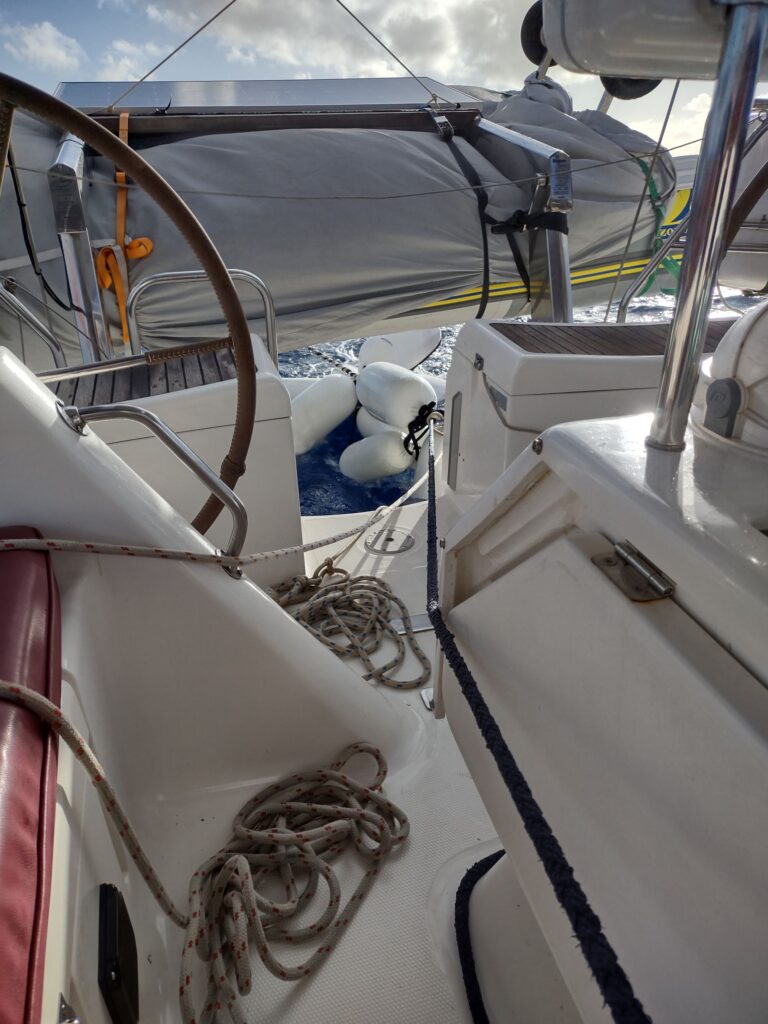
Next, the bags. The two backpacks are intact, but the drogue bag is missing. Never purchase a Lalizas Professional Sea Drogue No.1. By 14:00, we need to make a call on bringing in the spare main sail substitute drogue. There is less wind, and now we are losing speed. Bring her in. Thank you, sail, you saved us!!!! We still have one more line out that held the broken drogue. We leave this in as we are not mentally ready to let our imagined stability go.
We finally get enough signal and can let our family know we are safe. It is a short message that reads we are safe and have had a rough couple of days with high seas. If only they knew how petrified we were and how much we missed them. A new grib file downloaded forecasts lighter wind and waves ranging from 3.2 to 3.7 over the next two days. I hope it is correct this time round because we can sure do with some peace.
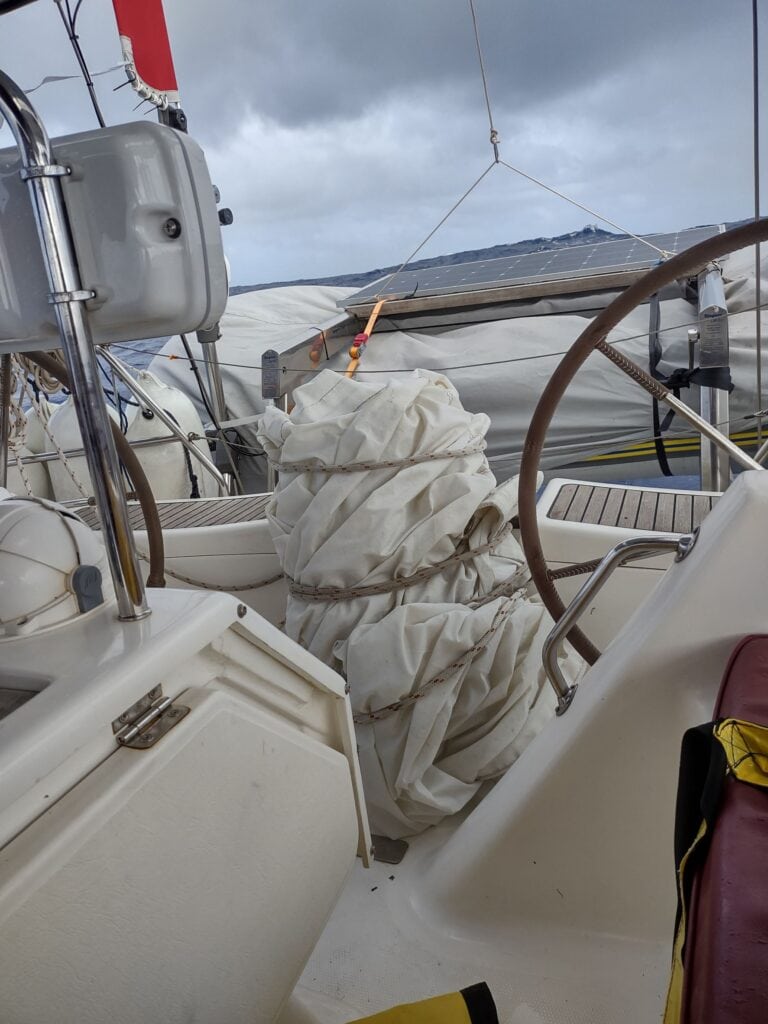
Sander and I can not believe that people would go to sea in conditions like these, and of course, the sea can get even worse than this. But we are relieved to read that the friends crossing ahead of us found this to be the worst weather they have encountered during their many crossings. Knowing this brings on more ease to us and our handling of Susie Jane. The waves are not playing ball yet, but the wind is. It’s time to bring in our last line. And there we are, a sailing boat sailing with the wind, with speed determined by the sail set-up. We can go back to our shift schedule again. And finally, get some sleep.
Day 16 29/12
Swell, swell, and more swell. Honestly, the next person to tell us that crossing is peaceful would be considered the luckiest person we know. It’s so rolly, to the extent you can’t stand, and your clothes are dirty and sweaty without a way to wash them. At least we have each other, and how fast one forgets how important that is.
I declare beer o’clock (we sure do deserve something out of the ordinary).
We are managing with the Hydrovane again, but due to the change in wind direction, our heading keeps changing. Back to the long S-line again. A couple of squalls come and go, and by daybreak, we are surrounded by clouds.
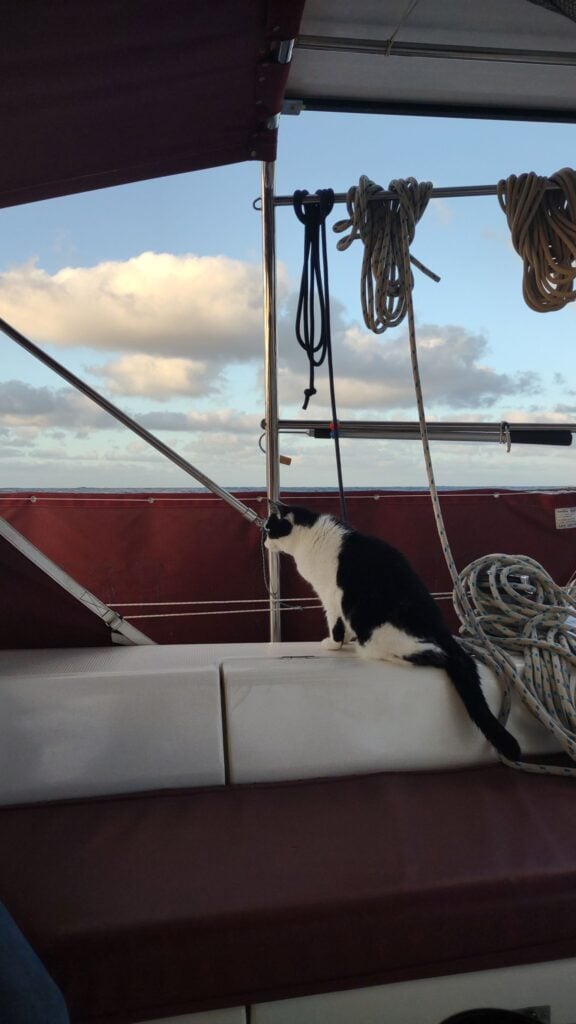
Day 17 30/12
We are struggling to get the head sail to settle with the waves moving us about. The constant banging is driving us crazy! We thought we would have more calm seas by now…damn you weather forecasting model. We are tired and just want to get to land. Ava wants to know if we will live in the Caribbean in a house (I think she is done sailing too).
The sea and wind turn in our favour, and we have an easy day and night of sailing. We have had to set our clocks back 5 hours to match Antigua time. An added 5 hours makes for a long day.
We attempt a game of Monopoly, but our little houses and hotels are flung across the table due to the rocking motion. Our water-maker is still out of action for the moment due to how much the boat is moving about.

Tonight is our first relaxed watch and we are now confident that we will safely make landfall.
Day 18 31/12
The last day of 2022. How can we make this a fun one? Sander prepares us a take-out meal; deep-fried fish fingers and chips. We watch films and have another go at Monopoly. The torment of the ocean has an impact on my face, and I have become a pre-pubescent with the skin of a warty frog.
We have stopped using Hydrovane as it is struggling to keep our course (yet again). One reason might be that we cannot put out the main sail too far as it wears on the spreaders and the batten gets stuck, and secondly, the amount of Sargassum seagrass getting stuck in the Hydrovane rudder.
The waves change, and the sea state becomes unbalanced again. What ever it is we do for our new years celebration, needs to be done safely.
We brought some sparklers, but the combination of wind and sparks on a polyester boat will not end well. Shooting off some of our old flares would only invoke fear at sea and a storm of lifeboats.
We wake the kids at 23:45 (Antigua time) and have some chocolate and stale wine with cherries. Countdown complete, and we each write a wish for 2023 on a paper plane and send it to the ocean. PS; I did not wish for more money or a bigger boat.
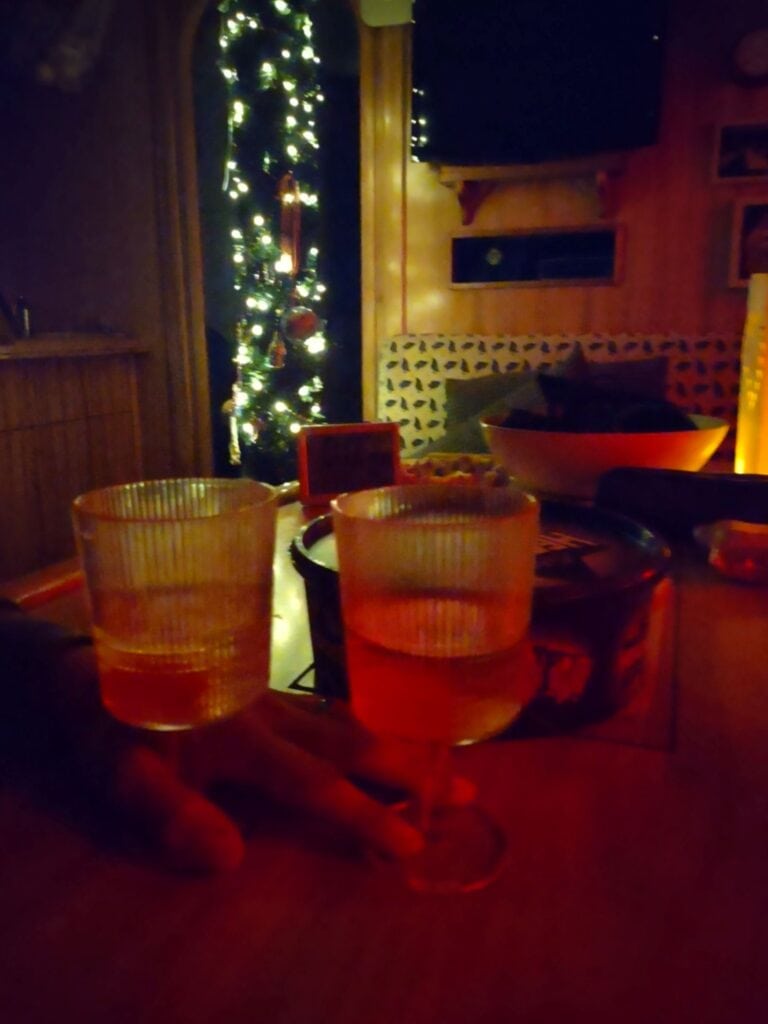
Day 19 01/01
The crossing seems endless. Today the morale on the boat has declined. It is a film day for all the crew. Before our departure, we copied tons of films from friends…luckily this included hours of animated and Starwars films (thank you again, Marc and Jona).
We have a breeze and an uncomfortable swell that jerks the boat about. Sander and I are too tired to do any significant chores on the ship. However, we tick one box and move a trash bag to the anchor locker.
The air is warm, and there are islands of Sargassum seaweed around us. We should arrive in the next three days. To ensure we arrive during the office hours of Jolly Harbour Marina, we need to maintain a speed of between 4.8 – 5.5 knots. Fingers crossed, here we go.
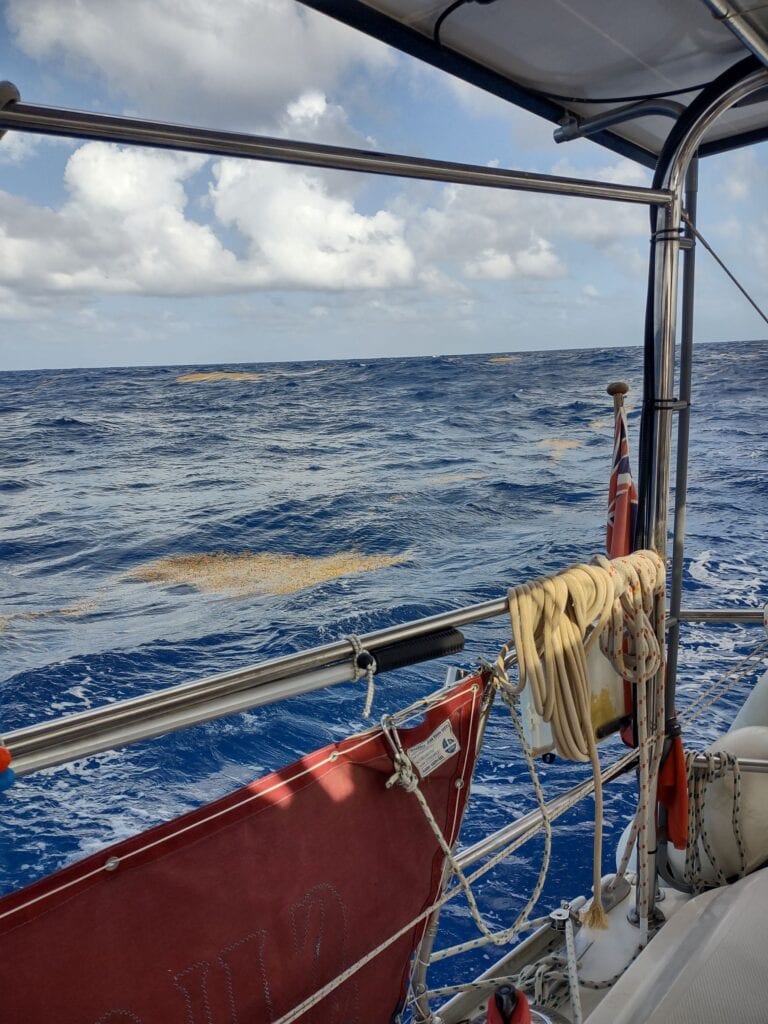
Day 20 02/01
Knowing that land is not too far away, we get on with some routine and necessary tasks:
- Washing underwear.
- Untying all the bowline knots on the mooring lines that held the drogue.
- Disassembling the drogue.
- Removing any salvageable bits from said drogue.
- Moving the spare main sail to the deck.
On closer inspection of the drogue, it is clear that the stitching had come undone…how revolting that bad stitching would be the potential demise of a family.
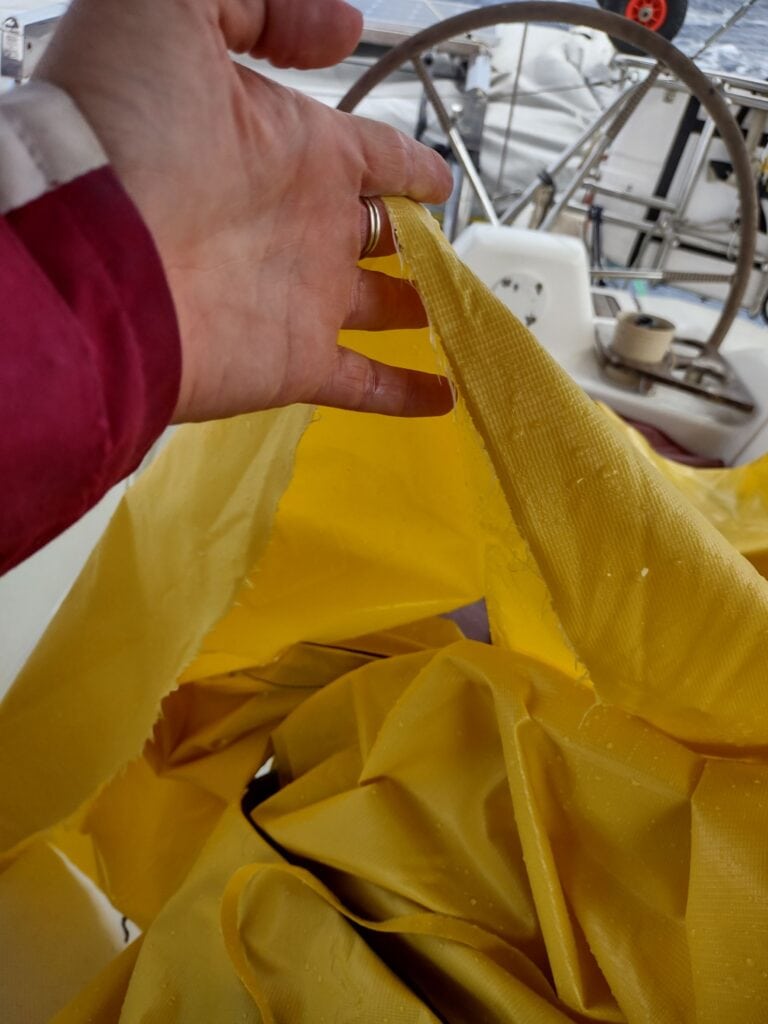
We have been trying to use the Hydrovane more than the autopilot where at all possible. We want to reduce engine hours as the batteries run low by 12pm, and using the Hydrovane is free. Sander has become a wizard at operating the Hydrovane and setting it for any change in the sea and wind. I still need to master a few tricks, but on a whole it is going well.
By 5 am, we have 144 miles to go. I’m so excited and already looking for lights.
Day 21 3/1
We have noticed a vibration on our prop when she spins. On closer inspection (the underwater camera’s last picture before a sudden death), it would appear we have snagged something.
We check the prop shaft in the inside of the hull and see the prop is no longer spinning. Luckily we have a rope cutter and after firing the engine up we manage to cut the lines. But, a lump of the unknown remains with us for the last miles.
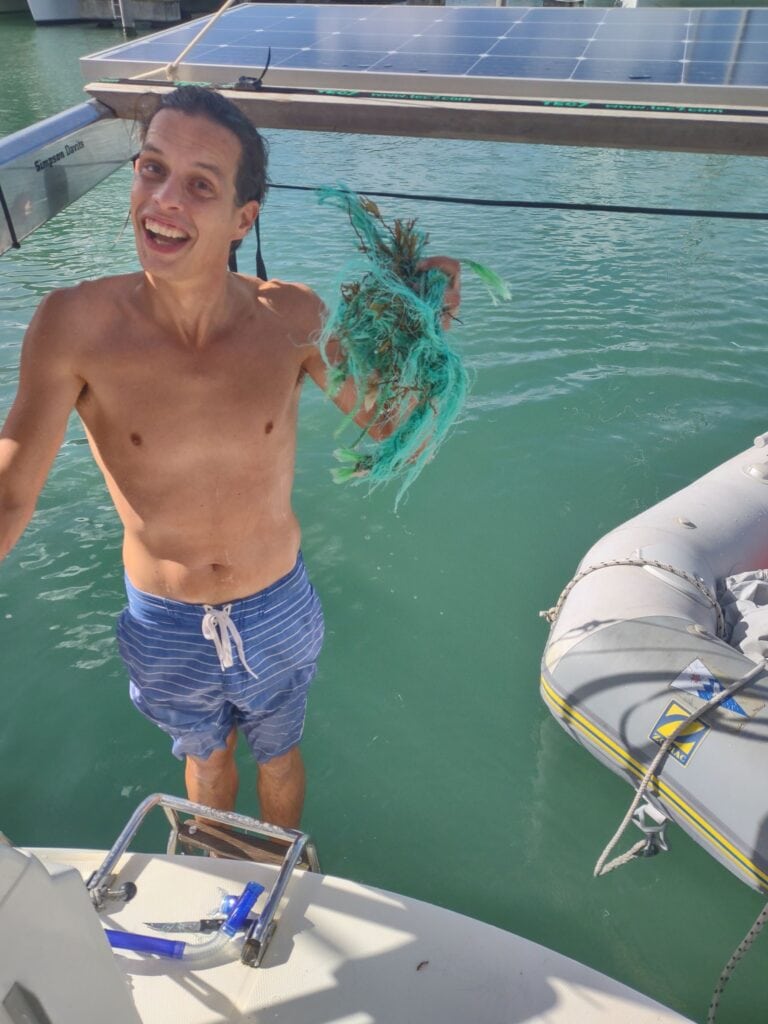
We fire up the SSB, but it will not connect. After two hours of fiddling about, the SSB connects, and we have a new weather file and have informed our contacts about our fowled prop.
Next item on the list…a courtesy flag. Before departure, we made many attempts at purchasing an Antigua courtesy flag (not mandatory, but a polite gesture to the country you are sailing into). La Gomera had none, so we thought we would make one as we go on the trip. Now is the moment of truth. With some ingenuity, an old shirt, muslin, a cleaning rag, an old sail bag, and a shopping bag, and Antiguan courtesy flag emerges. Let’s hope the officials like it.
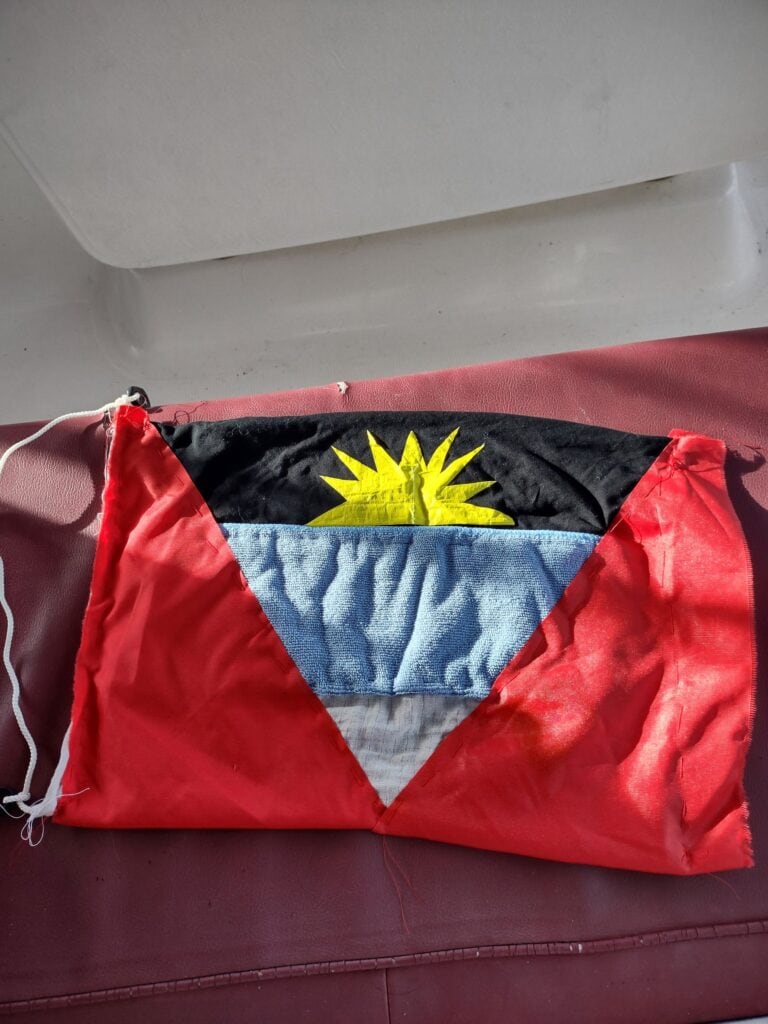
We have just under 50 miles to go and eagerly look out for lights. Nothing, but we do pick up on Guadeloupe’s transmissions. By 2:10 and 27 miles to go, there is land in sight. The fact that we are almost there is beyond me. We still feel the same tiredness. And yet, the end is so close. We have a full moon lighting the way and a large swell following. The wind picks up and dies down between 16-28 knots.
The last leg is always the hardest, I’m told.
We have a knock coming from the anchor locker. To ensure we do not lose our anchor out at sea, should one of the shackles or windlass decide to let go, we lash her down with some rope. But the multiple knots holding the anchor came undone. A quick fix and we inch closer to Antigua.
By dawn, we can see the shapes of the different mountains and make out where cars are driving. Antigua has a large rain shower stretching over it. Will we be able to miss it?
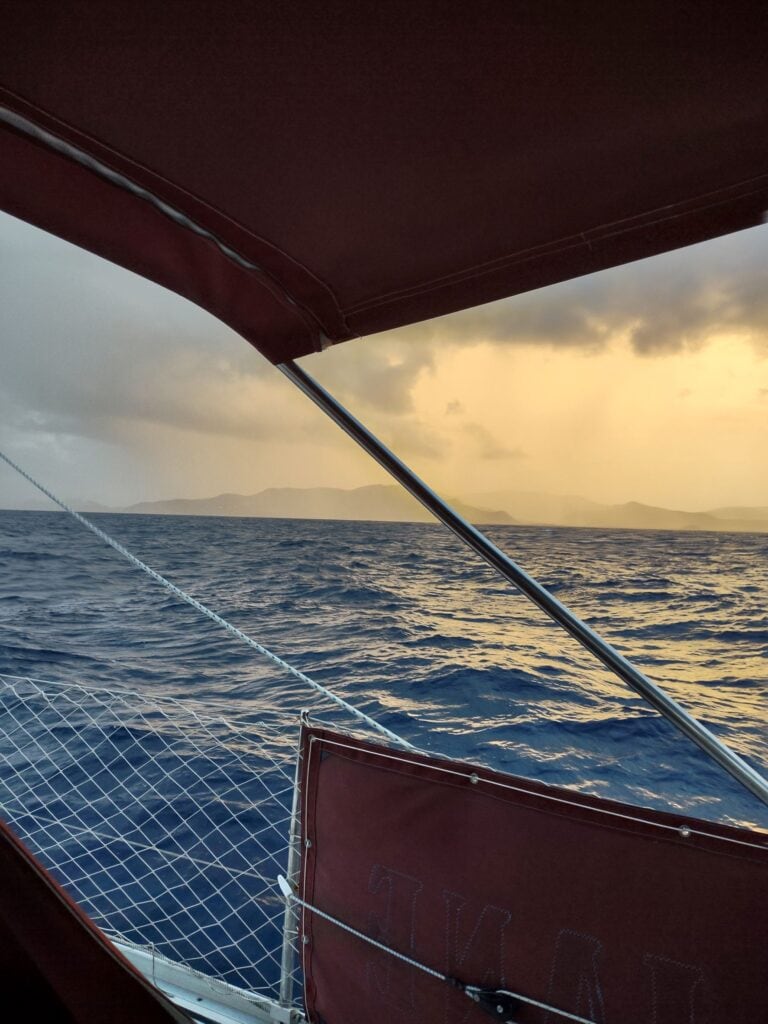

The kids wake up and are stoked to see land. We spend a couple minutes embracing the morning sun and views before racing the children downstairs. It looks like we will get some rain. Within a minute, we have a rain shower and the winds pick up from a steady 10 to 30 knots. Luckily our main sail is fully reefed, and with some team work, the head sail is fully reefed too. We are soaked and cleared of all the saltwater build-up from the days before. We let out some more sail, as we want to get there as soon as possible. Rainbows are around us, a tall ship in the distance, and countless masts in the bay in front of Jolly Harbour Marina. And then, nature takes one more swipe at us.

As we prepare the mooring lines and fenders, the wind builds from a breezy 15 knots to a howling 27. ‘Reef,’ ‘reef again,’ what is this madness.
And just as soon as it had arrived, it left. Sails down, engine on, we will motor the last mile. There is still a knock on the prop, but it does not matter now; we are so close.

We are surrounded by green hills and little islands, turquoise water so far removed from the swelling seas out on the horizon. It is two different worlds. Pelicans dive into the water like rockets falling from space, and a turtle peaks his head out of the water. The yellow Customs and Immigration building beckons us closer.
THE END
Progress Update on the Rowers (22 January 2023):
Salty (In Our Element) – With 102 Nautical miles to go. They have been rowing for 5 weeks and 5 days, and inching closer to land.
Woobie (Fight Oar Die) – Three weeks in, and their boat capsized with a rogue wave. The boats are meant to self-right, but not on this occasion. Following safety procedures, they got into their liferaft and drifted for 18 hours before being saved by a Dutch cargo ship who picked up on their faint EPIRB signal. The ship was heading for their designated port in Canada, after which the rowers would fly back to their loved ones. (Article found here).
Eppy (The Friendship) – The boys arrived a week or so after us and came in third place. Well done!!!
We have made it; we survived to decide how we continue our journey and how we live. Will we continue sailing knowing what lies out there or settle down on one of the islands we have crossed? It has been one hell of a ride (understatement), and we have a story to tell…an adventure shared between us. And it would not be an adventure if everything goes to plan (thank you Dylan).
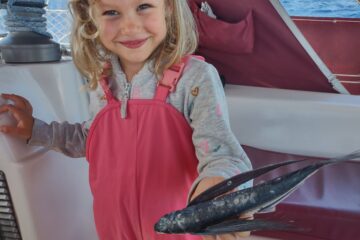
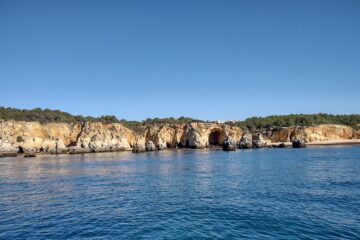
12 Comments
Lizani · April 3, 2023 at 10:41 am
What an interesting trip! Came across this VIA Facebook and was interested in reading whether or not the cat was okay (cat obsessed over here)
How did she experience the trip throughout the storm? Not sure if I missed it, is she okay too?
Danielle De Hoogh · April 3, 2023 at 11:23 am
Hi Lizani. Thank you for the comment. During the crossing she was pretty happy. No change in her behaviour, but by the 26th, when things kicked off, she found a hiding spot and stayed there until dinner time. When we started sailing she would get seasick, but this only lasted a couple weeks. She is a lot more adventurous now and seems content on the boat. Have a lovely day.
Eric (sv Abayomi) · January 24, 2023 at 9:01 am
What great writing skills you have! And all without holding back. Have read your adventures in one breath. What an experience for you all. So much learned on your first crossing. Reading makes me wonder if Nova still was able to use the kitty toilet:):). How did she manage? Was she never seasick?
You can all be proud of what you achieved. I trust the sailor’s amnesia will kick in soon now you have experienced the first few islands in the Caribien. Looking forward to the follow up stories. Enjoy your freedom.
Lots of love to you all xoxo
Danielle De Hoogh · January 24, 2023 at 12:35 pm
Dearest Els and Eric, thank you very much.
Nova was able to use the kitty toilet…luckily. we have a couple of videos where she is balancing herself out with the waves. Will share with you when you are here 😉 She was missing in action on the 26th. She hid somewhere unknown to us. Are you planning on bringing along a cat?
Miss you both and wishing you loads of strength and success getting Abayomi ready to see the world. xxxx
Jeanne Havenga · January 23, 2023 at 6:40 pm
Dear Danielle. What an adventure you have been on. There were times you thought you weren’t going to make it and that must have been so scary, but I am so thankful that you all made it and poor Suzie Jane must be quite battered but she also stood upto it. Well done for keeping Ava and Will and the cat calm during the turbulent times. Enjoy a well deserved break in Antiqua. Lots and lots of love to you all xxxxx
Danielle De Hoogh · January 24, 2023 at 12:37 pm
Dearest Aunty Jeanne and Uncle Dermott. Thank you for the uplifting words. The islands around here certainly make up for any hardships during a crossing. Wishing you both a wonderful day and lots of love from us all. xxx
Charles · January 23, 2023 at 2:18 pm
Wow what a scary adventure, so glad you are all safe!!!
I hope you had a lovely shower once on land.
Danielle De Hoogh · January 23, 2023 at 3:05 pm
Thank you Charles. As mentioned before…showers are for people who do not need to make or catch water 😉
Anne · January 23, 2023 at 1:46 pm
Great write up ….. keep us posted on your next adventures
Danielle De Hoogh · January 23, 2023 at 3:06 pm
Thank you Anne, our Crossing friends 😉 x
Laura Wrigley · January 23, 2023 at 1:02 pm
My dear cousin Danielle!!
What a journey you’ve been on!!
Thanks for taking the time to document (I was advised would need a tissue!!)
I cannot even begin to imagine what you guys have been through.
All I can say is well done, well done for keeping on, well done for working as an amazing team through relentless and unforgiving conditions. Sander and Danielle thank you for not giving up, for keeping on through the many days of ferocious waves and lack of sleep, you both fought so hard, so long, you did it and kept yourselves and your two gorgeous and precious kids safe.
Now to enjoy some stable land, food, sleep and time together.
Huge hugs all round, miss you all so much but love you lots 💞
Danielle De Hoogh · January 23, 2023 at 3:06 pm
Thank you Laura! It was intense, but there were dolphins too to keep things light. Lots of love to you all. xx